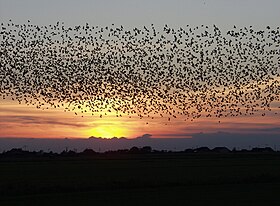List of Struthioniformes by population
| The population of birds |
|---|
 |
This is a list of Struthioniformes species by global population. While numbers are estimates, they have been made by the experts in their fields. For more information on how these estimates were ascertained, see Wikipedia's articles on population biology and population ecology.
This list is not comprehensive, as not all extant Struthioniformes have been enumerated.
Species by global population
[edit]| Common name | Binomial name | Population | Status | Trend | Notes | Image |
|---|---|---|---|---|---|---|
| Little spotted kiwi | Apteryx owenii | 1,200[1] | NT[1] | Minimum estimate.[1] |  | |
| Northern cassowary | Casuarius unappendiculatus | 3,500 – 15,000[2] | LC[2] |  | ||
| Great spotted kiwi | Apteryx haastii | 8,000[3] | VU[3] |  | ||
| Southern cassowary | Casuarius casuarius | 10,000 – 19,999[4] | LC[4] |  | ||
| Common emu | Dromaius novaehollandiae | 630,000 - 725,000[5] | LC[5] |  | ||
| Southern brown kiwi | Apteryx australis | 29,800[6] | VU[6] |  | ||
| North Island brown kiwi | Apteryx mantelli | 35,000[7] | VU[7] | Preliminary estimate.[7] |  |
See also
[edit]References
[edit]- ^ a b c d BirdLife International (2012). "Apteryx owenii". IUCN Red List of Threatened Species. Version 2012.2. IUCN. Retrieved 2012-12-13.
- ^ a b c BirdLife International (2012). "Casuarius unappendiculatus". IUCN Red List of Threatened Species. Version 2012.2. IUCN. Retrieved 2012-12-13.
- ^ a b c BirdLife International (2012). "Apteryx haastii". IUCN Red List of Threatened Species. Version 2012.2. IUCN. Retrieved 2012-12-13.
- ^ a b c BirdLife International (2012). "Casuarius casuarius". IUCN Red List of Threatened Species. Version 2012.2. IUCN. Retrieved 2012-12-13.
- ^ a b c BirdLife International (2019). "Dromaius novaehollandiae". IUCN Red List of Threatened Species. Version 2012.2. IUCN. Retrieved 2019-01-17.
- ^ a b c BirdLife International (2012). "Apteryx australis". IUCN Red List of Threatened Species. Version 2012.2. IUCN. Retrieved 2012-12-13.
- ^ a b c d BirdLife International (2012). "Apteryx mantelli". IUCN Red List of Threatened Species. Version 2012.2. IUCN. Retrieved 2012-12-13.


 French
French Deutsch
Deutsch